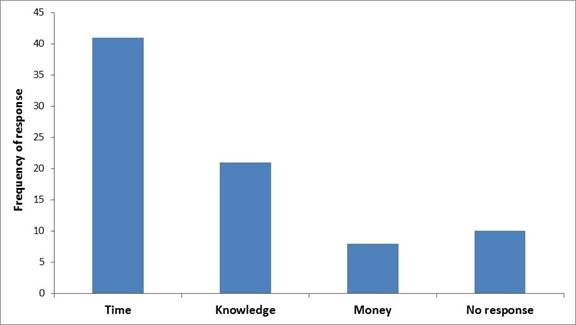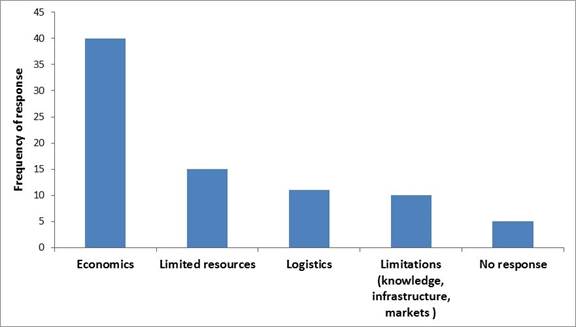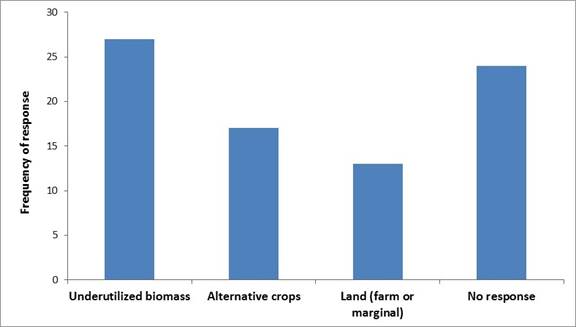 |
December 2016
|
December 2016 // Volume 54 // Number 6 // Research In Brief // v54-6rb1
Extension Professionals' Perspectives on Supporting Feedstock Production for Biofuels: Concerns, Challenges, and Opportunities
Abstract
The development of successful bioenergy programs will depend on informed and prepared Extension professionals who are willing and equipped to provide technical support. A survey of Extension professionals in the Pacific Northwest revealed barriers to program development, including limits on time and knowledge and concerns about economic returns for biofuel crops. Without the promise of market opportunities, Extension professionals may be unwilling to devote requisite resources to bioenergy programs. However, government policies and mandates make the rise of biofuels highly likely. Extension professionals should look to the future and consider blending bioenergy education into existing programs.
Introduction
During the past decade, there has been a push related to federal and state policies and federal funding to produce more energy from biomass, including purpose-grown bioenergy crops. For bioenergy programs to be successful, new knowledge and technology must be accessible to the growers who will supply feedstocks to fuel the new industry. Extension professionals will play an important role in helping these stakeholders develop feedstock production systems to support new and expanding bioenergy production (Fortson, 2006; Haider, Kar, Townsend, & Zobrist, 2015; Marra, Jensen, Clark, English, & Menard, 2012). Challenges to feedstock production and Extension programming arise when there is not a receptive audience for the relevant information.
Extension professionals are a critical conduit in the transfer of knowledge from researchers and industry to growers and other stakeholders. As the bioenergy industry expands, Extension professionals with agricultural and natural resource expertise will be called on to integrate bioenergy into their existing programs (Grebner, Perez-Verdin, Henderson, & Londo, 2009). In addition to supporting feedstock growers and suppliers, Extension professionals will need to interact with community members to engage and inform them and to encourage public participation in renewable energy projects (Haider et al., 2015). Often called "change agents" because of their expertise in extending sound scientific research, Extension professionals are well equipped to assist communities in dealing with public policy issues (Peek et al., 2015).
The growing demand for Extension materials that support bioenergy feedstock production is due in part to strong commitments by the U.S. Department of Agriculture and U.S. Department of Energy related to expanding the availability of locally sourced feedstocks to biorefineries. An estimate in the U.S. Billion-Ton Update report indicates that the United States will have between 1.1 billion and 1.6 billion tn of sustainable biomass available for industrial processing by 2030 (Perlack & Stokes, 2011). This amount of biomass could produce about 85 billion gal of renewable biofuels—enough to replace approximately 30% of the petroleum currently used. The report's authors project that by 2030 as much as half of the total biomass available will be from dedicated energy crops, with the remaining biomass coming from agriculture and forest wastes and residuals (Perlack & Stokes, 2011).
Federal agencies have invested significant funds for researching and developing bioenergy projects across the United States. Many of these funding opportunities involve a transdisciplinary approach and include Extension (Goldner, 2015). This circumstance offers potential sources of funding for cash-strapped Extension programs and requires that Extension professionals look to the future as contemporary Extension services evolve (Reed, Swanson, & Schlutt, 2015).
As feedstock supply chains are developed, growers, landowners, and communities will rely on Extension professionals as an objective source of scientific information concerning all aspects of the feedstock supply chain, including growing and collecting biomass for bioenergy production (Villamil, Alexander, Silvis, & Gray, 2012). Consequently, Extension professionals with agricultural and natural resource expertise are expected to play an important role in making emerging knowledge about biofuels accessible to and "digestible" by growers.
Because of the role Extension will play in facilitating bioenergy feedstock supply, it is important to understand the perceptions of Extension professionals related to incorporating bioenergy programming into their existing agriculture and natural resource programs. Taking a regional approach, we examined these perceptions in the Pacific Northwest. Understanding Extension professionals' views on enabling the accessibility and digestibility of biofuels knowledge and the adoption of biofuels technologies provides insights on facilitating feedstock production. It also enables better awareness of how Extension can make new knowledge and technology readily available to target audiences (growers, community members, etc.) throughout the United States.
Methods
In February and March 2013, we conducted an online survey of agriculture, natural resource, and bioenergy Extension agents and county directors in northern California, northern Idaho, Oregon, and Washington. We targeted Extension professionals in the region who were most suited to provide outreach and Extension services related to bioenergy to landowners and feedstock growers. We used SurveyMonkey and sent the survey electronically to 140 Extension professionals, following up with four reminders after the initial survey (Dillman, Smyth, & Christian, 2014).
We asked respondents to rate their levels of experience with bioenergy from high level of experience to no experience. We also asked three open-ended questions focused on
- the most challenging part of being an Extension professional and how bioenergy might make the respondent's job more challenging,
- barriers to producing biofuel crops in the respondent's county or region, and
- opportunities for producing biofuel crops in the respondent's county or region.
We conducted a qualitative content analysis by coding the data to identify common themes within the responses (Saldaña, 2013). Two of us grouped the responses into themes independently and compared our themes iteratively until we had a common agreement. The final categories of identified themes closely reflect the respondents' expressions of concerns about, barriers to, and opportunities for bioenergy production and Extension activities concerning bioenergy and biofuel crops. There were no limitations on the number of themes that could be attributed to each respondent. We computed the numbers of times main themes were expressed in the responses and developed histograms of frequency of occurrence of those themes. We selected quotes and histograms to illustrate the main themes and their prevalence.
Results
The total response rate for the survey was 58% (n = 81). A small number of respondents did not answer every question. The response rate was highest in northern Idaho and lowest in northern California. Only two respondents had high levels of bioenergy experience, eight had moderate levels of experience, and the remaining 67 had some to no experience with bioenergy (Figure 1).
Figure 1.
Extension Professionals' Reported Levels of Experience with Bioenergy

In expressing challenges to addressing bioenergy, lack of time was the most frequent issue raised by professionals across all experience levels, being mentioned by approximately 50% of the respondents. One respondent expressed the time limitation as "just one more iron in the fire." Additional common themes surrounding challenges included limited knowledge and limited funding (Figure 2). Other themes were communication challenges and environmental concerns. Several respondents mentioned both limited time and limited knowledge. For example, a respondent described there being "too many demands on time to become knowledgeable enough about bioenergy to be useful." In some cases, expressions of lack of time may actually have indicated other limitations, such as lack of interest, as indicated by one respondent: "Energy technology and policy simply doesn't seem to be high on the list for the people in my Extension network, and I don't have the time (or frankly interest) to develop the expertise . . ."
Figure 2.
Challenges Expressed Most Frequently by Extension Professionals
Related to Adding Bioenergy to Their Outreach Work

In identifying barriers to producing biofuel crops in their regions, approximately 50% of the respondents mentioned economics. One respondent expressed this issue simply as "markets, markets, and markets." Other terms respondents used that were related to the economics theme included profits and costs. Additional barriers included limited availability of resources such as land and water and logistics (Figure 3). One respondent specifically mentioned "lack of land" as a barrier to "producing large numbers of biofuel crops."
Figure 3.
Extension Professionals' Perceptions About Barriers Related to Producing Biomass for Biofuels in Their Regions

Related to opportunities to produce biomass for biofuels, over 30% of the respondents noted the availability of underutilized biomass in their regions (Figure 4). Many respondents mentioned opportunities for alternative crops as well as the availability of different types of land, including productive farmland and marginal land (Figure 4). One respondent stated that producing biomass for biofuels ". . . would open an even greater market for [the region's] cropable acres. . . ." Another respondent expressed that ". . . landowners are eager to find alternative markets and uses for marginal cropland."
Figure 4.
Extension Professionals' Perceptions About Opportunities Related to Producing Biomass for Biofuels in Their Regions

Discussion
Our results reveal some key challenges in fostering Extension education programming for bioenergy crops in the Pacific Northwest. One of the biggest challenges for Extension professionals is that they simply do not have enough time to branch out into new program areas. Budget cuts and the resulting staff cuts during the Great Recession resulted in even more overstretched Extension professionals and reduced programming ability (Harder, Moore, Mazurkewicz, & Benge, 2013; Serenari, Peterson, Bardon, & Brown, 2013). Lack of knowledge was another key challenge identified, but this obstacle also relates to the issue of time as Extension professionals can struggle to find time to learn new things (Lakai, Jayaratne, Moore, & Kistler, 2012). Using existing technical manuals, curricula, and other resources on bioenergy crops could help Extension professionals with this challenge as they integrate bioenergy programming into their existing programs.
Given time constraints, Extension professionals must prioritize content areas for programming. This situation relates to a key barrier to bioenergy programming in Extension: the lack of clear, established market opportunities for bioenergy crops. Poor economic viability was the top barrier to bioenergy crop production identified by Extension professionals in our study (Figure 3). Without markets, growers have no reason to grow bioenergy crops, and Extension professionals have no reason to offer bioenergy education programs. Both the crops and the education programs are demand driven.
Concerns about the economic viability of bioenergy crops are exacerbated by perceived negative past experiences. For example, one respondent noted, "I think one key barrier will be the 'once bitten, twice shy' experience for landowners. Many got excited about crops like hybrid poplar in the '90s, only to be disappointed by the lack of broad product and market development." Another respondent mentioned failed past attempts at developing local bioenergy markets: "We have had many instances where bioenergy companies have come into small agriculture communities and oversold themselves and the money to be made in biofuels. They have often received local government funding or local investor money and then have disappeared." Given these past experiences and current perceptions, growers and Extension professionals are likely to be wary of bioenergy crop production until successful, consistent returns to landowners can be demonstrated.
Respondents identified potential opportunities related to bioenergy production, including existing underutilized biomass and interest in alternative crops, especially those that can be grown on marginal lands. Thus, if good market opportunities emerge, Extension professionals are of the view that there will be a variety of opportunities on the landscape and willing growers. As one respondent said, "From a cropping standpoint, we have farmers who have always been willing to try new things if risk can be minimized." These willing growers can serve as entry points for outreach and Extension efforts.
Conclusion and Recommendations
Very few Extension professionals in the Pacific Northwest have substantial experience with bioenergy. Most feel they would have to devote scarce resources to develop bioenergy programs. Our results suggest that Extension professionals in the Pacific Northwest may find developing such programs difficult. Extension professionals in other areas of the United States may be in similar situations and may remain reluctant until there is established interest among their clientele for bioenergy crops.
Concern over energy security and the environmental impacts of fossil fuels, as well as the desire to create economic opportunities in rural communities, has prompted considerable development of policies, government programs, and market investments that support biofuels development. This broad support for the commercial production and use of biofuels has made the rise of biofuels likely inevitable, even with the current barriers to production.
Extension professionals may need to consider the need to be "change agents" regarding energy and direct their clientele toward future needs. Proactive Extension professionals should seek out funding opportunities and identify energy outreach messages that can be blended into existing programs (Geiger, 2014). With a billion tons of biomass needed to support bioenergy developments by 2030, agriculture and natural resource Extension professionals would benefit by sharing university energy research to create a dialogue on local energy goals and challenges (Romich, 2015). Although on-the-ground programs specific to growing bioenergy crops may be premature at this time, building a baseline of energy literacy knowledge among Extension clientele will be beneficial.
Grant programs that increase Extension capacity by funding dedicated bioenergy Extension specialists may help establish an initial foundation of Extension bioenergy resources. General technical manuals for bioenergy crops and program curricula that are easily transferable/replicable across a region and across the United States could be particularly useful tools to have ready for Extension professionals when economic opportunities for bioenergy crops arise.
Acknowledgments
This research was supported by Agriculture and Food Research Initiative Competitive Grant no. 2011-68005-30407 from the U.S. Department of Agriculture National Institute of Food and Agriculture. The Extension professionals at the Snohomish County, Washington, Extension office provided valuable feedback in developing the survey questions. Jim Funck and Shiba Kar helped with the survey design. We also thank all of the Extension professionals throughout the Pacific Northwest who participated in our survey as well as the three anonymous reviewers of our manuscript.
References
Dillman, D. A., Smyth, J. D., & Christian, L. M. (2014). Internet, phone, mail, and mixed-mode surveys: The tailored design method (4th ed.). Hoboken, NJ: John Wiley & Sons.
Fortson, L. (2006). 25 by '25: Extension's role in rural energy development. Journal of Extension, 44(5) Article 5TOT3. Available at: http://www.joe.org/joe/2006october/tt3.php
Geiger, M. (2014). Energy extension is central to sustainability. Rural connections: A publication of the Western Rural Development Center. Retrieved from http://wrdc.usu.edu/files/publications/publication/pub__7800913.pdf
Goldner, W. (2015). National Institute of Food and Agriculture bioeconomy-bioenergy-bioproducts portfolio strategic plan 2014 progress and implementation report. Retrieved from https://nifa.usda.gov/sites/default/files/resource/Bioeconomy-Bioenergy-Bioproduct%20Portfolio%20Strategic%20Plan_0.pdf
Grebner, D. L., Perez-Verdin, G., Henderson, J., & Londo, A. (2009). Bioenergy from woody biomass, potential for economic development, and the need for Extension. Journal of Extension, 47(6) Article 6FEA7. Available at: https://www.joe.org/joe/2009december/index.php
Haider, N. M., Kar, S. P., Townsend, P. A., & Zobrist, K. W. (2015). Growing green energy: A review of Extension's role in the development of advanced biofuels. Journal of Extension, 53(1) Article 1FEA2. Available at: http://www.joe.org/joe/2015february/a2.php
Harder, A., Moore, A., Mazurkewicz, M., & Benge, M. (2013). Problems impacting Extension program quality at the county level: Results from an analysis of county program reviews conducted in Florida. Journal of Extension, 51(1) Article 1RIB2. Available at: http://www.joe.org/joe/2013february/rb2.php
Lakai, D., Jayaratne, K. S. U., Moore, G. E., & Kistler, M. J. (2012). Barriers and effective educational strategies to develop Extension agents' professional competencies. Journal of Extension, 51(4) Article 4RIB1. Available at: http://www.joe.org/joe/2012august/rb1.php
Marra, A. E., Jensen, K. L., Clark, C. D., English, B. C., & Menard, R. J. (2012). Information sources and farmers' attitudes toward switchgrass production as a biofuel feedstock. Journal of Extension, 50(5) Article 5RIB6. Available at: http://www.joe.org/joe/2012october/rb6.php
Peek, G. G., Sanders, L. D., Shideler, D., Ferrell, S. L., Penn, C. J., & Halihan, T. (2015). Framing a public issue for Extension: Challenges in oil and gas activity. Journal of Extension, 53(5) Article 5FEA1. Available at: http://www.joe.org/joe/2015october/a1.php
Perlack, R. D., & Stokes, B. J. (2011). U.S. Billion-Ton Update: Biomass supply for a bioenergy and bioproducts industry. U.S. Department of Energy. Report: ORNL/TM-2011/224. Oak Ridge, TN. Retrieved from http://www1.eere.energy.gov/bioenergy/pdfs/billion_ton_update.pdf
Reed, A. S., Swanson, L., & Schlutt, F. (2015). Timberline manifesto: Seven concepts linking Extension and engagement. Journal of Extension, 53(4) Article 4COM1. Available at: http://www.joe.org/joe/2015august/comm1.php
Romich, E. (2015). The role of Extension in energy education. Journal of Extension, 53(2) Article 2COM1. Available at: http://www.joe.org/joe/2015april/comm1.php
Saldaña, J. (2013). The coding manual for qualitative researchers (2nd ed.). Thousand Oaks, CA: Sage Publications Ltd.
Serenari, C., Peterson, M. N., Bardon, R. E., & Brown, R. D. (2013). The impacts of the Great Recession on state natural resource Extension programs. Journal of Extension, 51(4) Article 4FEA11. Available at: http://www.joe.org/joe/2013august/a11.php
Villamil, M., Alexander, M., Silvis, A. H., & Gray, M. E. (2012). Producer perceptions and information needs regarding their adoption of bioenergy crops. Renewable and Sustainable Energy Reviews, 16. Retrieved from http://www.sciencedirect.com/science/article/pii/S13640321120021




